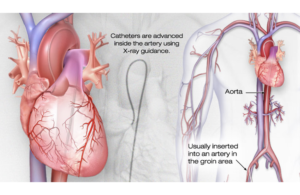
Diagnostic tests can be performed using the catheter during catheterization, according to the Mayo Clinic. Coronary angioplasty and coronary stenting are also performed using cardiac catheterization.
Doctors usually perform cardiac catheterizations to test for heart disease. They can also locate narrowing blood vessels, measure pressure and oxygen levels in different parts of the heart, check pump functions, biopsy, diagnose congenital heart defects and identify heart valve issues using catheterizations.
It can also be used during procedures to close holes in the heart and fix congenital defects, repair or replace heart valves, open narrow heart valves, treat irregular heart rhythms with ablation and to close off parts of the heart to prevent blood clots, according to the Mayo Clinic.
Cardiac catheterization procedures take around 30 minutes but could result in preparation and recovery times of several hours.
How does it work?
The procedure is minimally invasive and requires the patient to be awake. Patients are given mild sedatives to relax and are administered a local anesthetic to numb catheter insertion sites.
The catheter is inserted using a plastic introducer sheath and guided through the blood vessel to coronary arteries using a special X-ray imaging machine, according to the Cleveland Clinic.
A contrast material is then injected through the catheter to produce images on the X-ray as the material moves through the heart’s chambers, valves and vessels. Digital photographs from the X-ray are used to diagnose narrowing or blockages of the coronary arteries.

